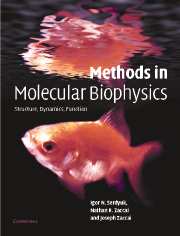Book contents
- Frontmatter
- Contents
- Foreword by D. M. Engelman
- Foreword by Pierre Joliot
- Preface
- Introduction: Molecular biophysics at the beginning of the twenty-first century: from ensemble measurements to single-molecule detection
- Part A Biological macromolecules and physical tools
- Part B Mass spectrometry
- Part C Thermodynamics
- Part D Hydrodynamics
- Part E Optical spectroscopy
- Part F Optical microscopy
- Chapter F1 Light microscopy
- Chapter F2 Atomic force microscopy
- Chapter F3 Fluorescence microscopy
- Chapter F4 Single-molecule detection
- Chapter F5 Single-molecule manipulation
- Part G X-ray and neutron diffraction
- Part H Electron diffraction
- Part I Molecular dynamics
- Part J Nuclear magnetic resonance
- References
- Index of eminent scientists
- Subject Index
- References
Chapter F5 - Single-molecule manipulation
from Part F - Optical microscopy
Published online by Cambridge University Press: 05 November 2012
- Frontmatter
- Contents
- Foreword by D. M. Engelman
- Foreword by Pierre Joliot
- Preface
- Introduction: Molecular biophysics at the beginning of the twenty-first century: from ensemble measurements to single-molecule detection
- Part A Biological macromolecules and physical tools
- Part B Mass spectrometry
- Part C Thermodynamics
- Part D Hydrodynamics
- Part E Optical spectroscopy
- Part F Optical microscopy
- Chapter F1 Light microscopy
- Chapter F2 Atomic force microscopy
- Chapter F3 Fluorescence microscopy
- Chapter F4 Single-molecule detection
- Chapter F5 Single-molecule manipulation
- Part G X-ray and neutron diffraction
- Part H Electron diffraction
- Part I Molecular dynamics
- Part J Nuclear magnetic resonance
- References
- Index of eminent scientists
- Subject Index
- References
Summary
Historical review and introduction to biological problems
1986
A. Ashkin and coworkers proposed the idea of an optical trap (tweezers). An optical trap can be produced with a highly focused laser light, and can be used to grab, move and apply measurable forces on micrometre-sized objects, such as dielectric microspheres. A microsphere that is chemically coupled to a molecule of interest provides a means of measuring the molecule's position and the force that it exerts.
1992
K. Bustamante and coworkers pioneered direct mechanical measurements of the elasticity of single DNA molecules using magnetic trapping. In 1994 S. Chu and coworkers studied the relaxation properties of single DNA molecules using optical trapping and G. Li and colleagues made a direct measurement of the force between complementary strands of DNA with atomic force microscopy. Mechanical properties of individual strands and doubled-stranded DNA have been determined. In 1997 G. Shivashankar and A. Libchaber developed a new technique for single DNA molecule grafting and manipulation using combined atomic force microscopy and an optical tweezer. These studies opened up new possibilities in biosensors and bioelectronic devices.
1993
K. Svoboda and coworkers applied optical trapping nanometry (optical tweezers in conjunction with nanometre-precision position detection schemes) to study a single kinesin molecule.
- Type
- Chapter
- Information
- Methods in Molecular BiophysicsStructure, Dynamics, Function, pp. 709 - 764Publisher: Cambridge University PressPrint publication year: 2007



